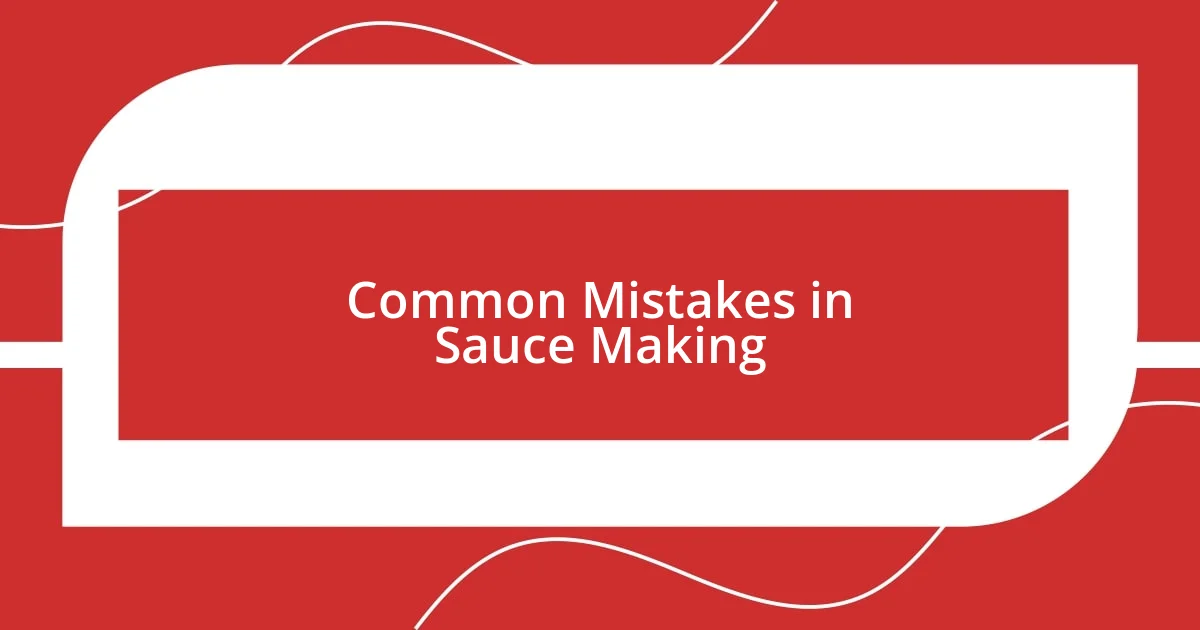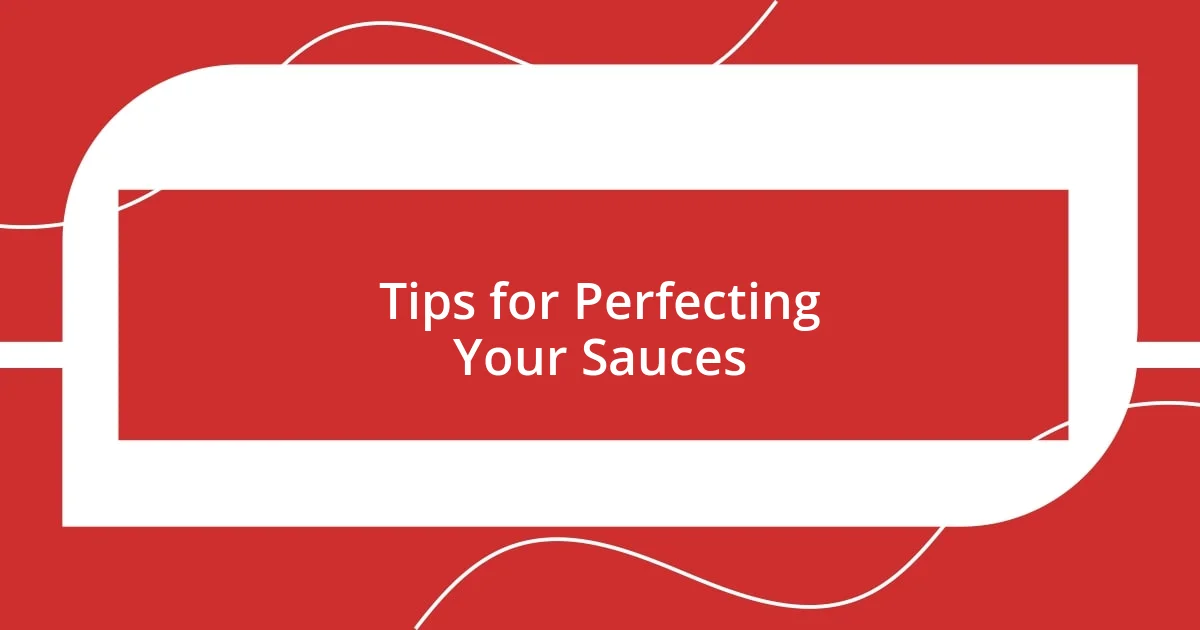Key takeaways:
- Gourmet sauces transform simple dishes through careful balance of core ingredients and techniques, such as caramelization and deglazing, to develop rich flavors.
- Common mistakes in sauce making include rushing the process, neglecting seasoning, and avoiding experimentation; patience and creativity can significantly enhance outcomes.
- Classic gourmet sauces like béchamel, demi-glace, and hollandaise can be successfully adapted with unique variations that add depth and interest to traditional recipes.

Introduction to Gourmet Sauces
Gourmet sauces are more than just condiments; they are a celebration of flavor, creativity, and culinary passion. I remember the first time I tasted a gourmet sauce; it was a velvety truffle aioli that transformed a simple dish into something extraordinary. Isn’t it fascinating how a single sauce can elevate a meal from ordinary to unforgettable?
As I delved deeper into the world of gourmet sauces, I discovered the endless combinations of ingredients, techniques, and cultural influences that can shape their unique profiles. I often find myself pondering: What truly defines a sauce as “gourmet”? For me, it’s the meticulous attention to detail and the skillful balance of flavors that create a memorable dining experience.
Each sauce tells a story, whether it’s a classic béchamel that channels French culinary traditions or a bold chimichurri that reflects vibrant South American cuisine. The emotional connection I feel when crafting these sauces is profound, as they have the power to evoke nostalgia, inspire creativity, and invite others to share in the joy of a well-prepared meal. How do you feel when a sauce enhances your favorite dish?

Essential Ingredients for Sauces
When imagining the foundation of any gourmet sauce, I think of a few core ingredients that truly set the tone. These ingredients are not just staples; they lay the groundwork for flavor, texture, and even aroma. For instance, I always reach for fresh herbs to add brightness and complexity. There’s nothing quite like the vibrant smell of basil or parsley as they mingle with warm oils in a pan—it’s a sensory experience that brings back memories of cooking in my grandmother’s kitchen.
Here’s a rundown of essential ingredients that can elevate your sauce game:
- Fats: Olive oil, butter, or cream for a rich mouthfeel.
- Acids: Vinegars, citrus juices, and wines to balance flavors.
- Sweeteners: Honey or sugar for contrast and depth.
- Aromatics: Onions, garlic, and shallots for foundational flavors.
- Proteins: Broths or stocks that enhance richness and complexity.
- Spices and Seasonings: Salt, pepper, and various spices to enhance and round out flavors.
- Herbs: Fresh or dried herbs to add vibrancy and personal touch.
Each ingredient has its own story and purpose. I remember once creating a spicy chipotle sauce where the smoky heat was perfectly counterbalanced by a splash of lime juice. It reminded me of my travels in Mexico, where vibrant flavors come alive in every bite. This is what I love about sauce-making; it connects me to memories and experiences while allowing me to craft something new.

Techniques for Flavor Development
Developing deep, complex flavors in gourmet sauces is an art form that requires an assortment of techniques. One effective method I often employ is caramelization. By cooking ingredients like onions or garlic slowly until they’re golden brown, I unlock natural sugars and develop a rich, sweet flavor base. This technique not only enhances taste but also adds a beautiful color, making the sauce more visually appealing. Have you ever experienced that moment when the scent of caramelized garlic fills the kitchen? It’s mouthwatering!
Another technique I find invaluable is deglazing. After searing meats or sautéing vegetables, I pour in a splash of wine or broth to lift those tasty browned bits stuck to the pan. This not only creates a depth of flavor but also ensures that nothing goes to waste. In my early attempts at crafting sauces, I neglected this step, and the difference it made when I finally embraced it was like night and day. It’s a simple act, yet it offers a world of flavor that truly resonates on the palate.
Lastly, layering flavors through building is essential. This involves adding ingredients in stages—starting with aromatics, then adding spices, followed by liquids and finishing touches like herbs. For instance, when I make a tomato-based sauce, I start with garlic and onions, infuse it with spices, then gradually add tomatoes and simmer. When it all comes together, the result feels harmonious, much like the notes in a song that build towards a beautiful crescendo. It’s those moments that remind me why I fell in love with gourmet sauce-making in the first place; every step feels like a dance of flavors.
| Technique | Description |
|---|---|
| Caramelization | Slowly cooking ingredients like onions or garlic to develop natural sweetness and rich flavor. |
| Deglazing | Adding liquid to lift browned bits from the pan, creating depth and richness in the sauce. |
| Layering | Building flavors by adding ingredients in stages for a harmonious and complex sauce. |

Common Mistakes in Sauce Making
One of the biggest pitfalls in sauce making that I’ve come across is rushing the process. I remember once, in my eagerness to whip up a creamy Alfredo, I tossed everything together too quickly. The result? A grainy mess instead of a silky sauce. It made me realize that patience really is a virtue in the kitchen; letting flavors meld together takes time, just like building a good relationship.
Another common mistake I’ve observed is overlooking the importance of seasoning. Early in my culinary journey, I often forgot to taste as I cooked, thinking the final sprinkle of salt would magically fix everything. Spoiler alert: it didn’t. Incorporating salt or other seasonings at different stages can drastically change the flavor profile, giving the sauce the balance it desperately needs.
Finally, I often find that people shy away from experimenting with ingredients. One time, during a dinner party, I decided to add unexpected spices to a tomato sauce. The subtle hint of cinnamon transformed the dish and sparked conversation. Why stick to the traditional when the thrill of gourmet cooking lies in exploration? Embracing creativity can turn a simple sauce into something extraordinary.

Recipes for Classic Gourmet Sauces
When I think of classic gourmet sauces, a few staples come to mind, and nothing beats a velvety béchamel. This white sauce is the foundation for so many dishes, and crafting it requires just a few ingredients: butter, flour, and milk. I remember the first time I made it; as I whisked the flour into the bubbling butter, the anticipation grew. Once I added the milk, the transformation was magical—smooth and creamy, it opened the door to a world of possibilities, like lasagna or a luscious mac and cheese.
Another classic that I adore is a rich, shiny demi-glace. This sauce is essentially a labor of love, requiring hours of simmering stock, wine, and aromatics until it reduces to a syrupy perfection. The first time I attempted it, the kitchen filled with tantalizing aromas that reeled in my family. The moment I drizzled it over a perfectly cooked steak, I felt as if I had created something truly special. Have you ever been proud of a dish you made, just wanting to share it with everyone around you?
Lastly, there’s the versatile hollandaise sauce, infamous for its creamy texture and buttery flavor. Making it felt like an experiment because of that delicate balance between egg yolks and melted butter. I still chuckle when I think about my first attempt—let’s just say the kitchen staff had an interesting breakfast that day! Once I got it right, however, it was delightful, transforming simple asparagus into something sophisticated. It’s those moments of trial and triumph that keep me experimenting and growing in my sauce-making journey.

Creative Variations on Sauces
I love the idea of putting unique twists on classic sauces. One time, while trying to impress some friends, I infused basil into a traditional pesto. The aroma that filled my kitchen was intoxicating! It was as if summer had come alive in a jar. This simple modification sparked a conversation about flavor preferences, and it reminded me how small changes can elevate a product from familiar to unforgettable.
Experimenting with different bases has also proven exciting. I once swapped cream for coconut milk in a curry sauce, believing the rich, tropical flavor would surprise my guests. To my delight, the result was a creamy, dreamy sauce that paired beautifully with shrimp. Have you ever taken a risk in the kitchen that turned out to be a game-changer? It’s those surprising moments that ignite my passion to keep exploring new combinations and ideas.
Another variation I cherish is the play on spiciness. There was a time I decided to add chipotle to a classic barbecue sauce. The heat brought an unexpected depth, making it perfect for grilled chicken. Watching my family’s faces as they tasted it was priceless. It’s in these moments that I realize how experimenting with different spice levels can transform a familiar sauce into something magical and memorable.

Tips for Perfecting Your Sauces
To perfect your sauces, attention to detail is key. I always recommend tasting frequently throughout the cooking process. My first experience with this was when I was making a red wine reduction. The more I sampled, the more I understood how each ingredient contributed to the overall flavor. It’s essential to find that balance; sometimes a dash of salt or a squeeze of lemon can elevate the sauce in ways you wouldn’t expect.
Don’t underestimate the power of fresh herbs. When I added a handful of chopped parsley to my béchamel, it instantly brightened the dish. It was like magic—the transformation was so remarkable that I couldn’t help but think of all the other sauces that could benefit from a touch of freshness. Have you ever noticed how herbs can awaken the palate? That’s why I always keep a variety on hand to experiment with.
Lastly, the technique of building flavors can’t be ignored. I had a revelation while making a tomato sauce when I realized that sautéing onions and garlic until they’re caramelized makes all the difference. This depth of flavor added a richness that I had previously overlooked. Right then and there, I learned that patience and layering ingredients truly enhances your cooking. What techniques have you discovered that changed your approach in the kitchen? Those little insights can often lead to huge improvements.















